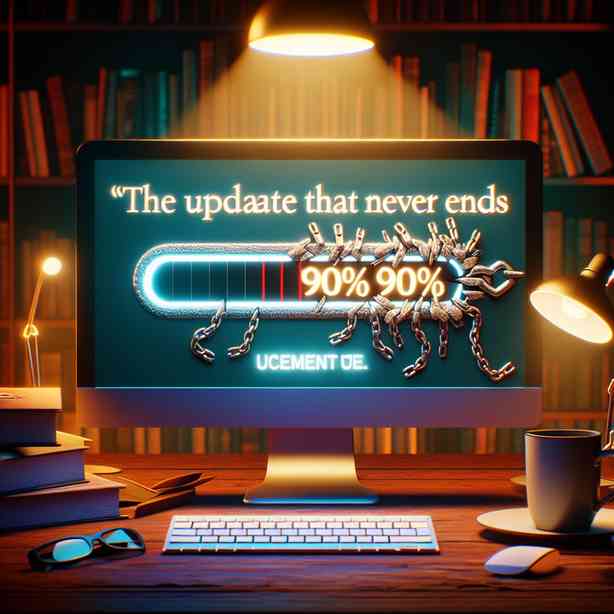
In the fast-paced world of technology, updates are a routine part of life, yet there are instances where updates seem to stretch on indefinitely. This phenomenon can lead to frustration, confusion, and a sense of helplessness for users. What drives these persistent updates? In this discussion, we will explore the concept of “The Update That Never Ends,” examining the causes, implications, and potential resolutions of this modern conundrum.
First and foremost, it’s essential to understand what is meant by endless updates. In a digital landscape where software, applications, and operating systems are continually evolving to meet user needs and security requirements, updates are necessary for optimal performance. However, there are times when updates appear to loop infinitely, causing users to question the very system they rely on.
One of the primary reasons for constant updates stems from the increasing complexity of software applications. With the rapid advancement in technology, software developers are consistently adding new features, fixing bugs, and addressing security vulnerabilities. This process is crucial, but it can lead to a cycle where each update necessitates another. For instance, a routine security patch might introduce new features that, in turn, require further adjustments and updates.
Moreover, the rise of agile development methodologies has changed the update landscape significantly. Agile practices prioritize delivering small, incremental updates rather than large, bundled releases. While this approach allows for more frequent improvements and faster responses to user feedback, it can create an environment where updates feel never-ending. Users may find themselves confronted with frequent notifications requesting them to update their software, leading to the impression that the updating process is ongoing.
Another critical aspect to consider is the impact of user behavior on the need for updates. Many users may not regularly update their devices or applications, leading to an accumulation of necessary updates over time. When users finally decide to update, they may be met with a long list of pending updates, creating a daunting task. This can result in a feeling of being overwhelmed, reinforcing the notion that updates are endless.
Furthermore, manufacturers and developers have a responsibility to provide clear communication regarding updates. When updates are not well explained or when release notes are vague, users can feel lost and frustrated. Properly informing users about what each update entails—whether it’s a bug fix, security enhancement, or feature addition—can mitigate feelings of confusion. Transparency fosters trust, encouraging users to engage with updates rather than avoid them.
The implications of an environment with endless updates can be far-reaching. From a user experience perspective, constant updates can lead to software fatigue. As users become accustomed to seeing update prompts, they may start to disregard them, resulting in outdated software and a host of security vulnerabilities. Moreover, companies may suffer from reputational damage if users believe that their products are unreliable or cumbersome due to persistent update issues.
In today’s interconnected world, where the importance of cybersecurity cannot be overstated, the role of updates becomes even more critical. Businesses are particularly vulnerable to threats if they fall behind on updates. Cybercriminals are constantly on the lookout for unpatched software to exploit, making timely updates essential for safeguarding sensitive information. Therefore, understanding and addressing the factors contributing to endless updates is not only a matter of convenience but also a necessity for maintaining security.
So, what can be done to address the issue of updates that never seem to end? First and foremost, adopting an organized approach to updates can make a significant difference. Users should develop a routine for checking and installing updates, ensuring that they are never too far behind. This proactive mindset not only streamlines the updating process but also helps to minimize the anxiety associated with a backlog of updates.
Additionally, software developers and companies should focus on improving the user experience around updates. Offering customization options—such as allowing users to choose when to receive updates or providing a summary of changes—can enhance satisfaction. Providing educational resources that explain the importance of updates can also empower users. When users understand the reasoning behind updates, they are more likely to embrace the process rather than resist it.
Lastly, there’s a growing trend toward offering users control over their update preferences. Options to defer updates or select specific features to install can significantly improve the user experience. Such flexibility allows users to tailor their technology usage based on personal needs and schedules, alleviating the sense of frustration that often accompanies endless updates.
As we navigate the landscape of technology and its perpetual updates, balancing the need for security and functionality with a hassle-free user experience is essential. By understanding the reasons behind the endless update cycle, embracing proactive measures, and fostering transparent communication, we can transform the experience from one of annoyance to one of empowerment.
In conclusion, while the concept of “The Update That Never Ends” may seem like a daunting reality, it is essential to recognize that updates serve a valuable purpose in keeping our software functional and secure. By tailoring our approach and understanding the dynamics at play, we can effectively manage updates, ensuring a smoother, more reliable relationship with technology. The next time you encounter that update prompt, remember that you are participating in a crucial aspect of maintaining your digital world—making each update worth the wait.


